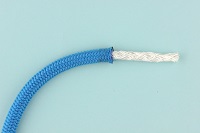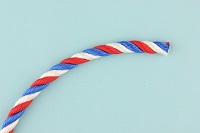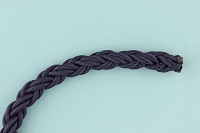Mooring ropes: The ultimate guide
What is a mooring rope?
Mooring ropes are used to securely fasten a boat to a jetty, quay wall, pile mooring or bollard. These ropes are also known as shore ropes or boat ropes. Whenever your boat is not moving, mooring ropes ensure that it is held securely and undamaged at its berth. It is therefore crucial that your mooring ropes reliably support the weight of your boat and are of high quality.
Below you will find important expertise to help you choose the right mooring ropes. At Premiumropes, we manufacture your mooring ropes to your desired dimensions in 1-2 days and ship worldwide.


What are the different mooring ropes?
Whether tender, dinghy, cruising yacht, regatta yacht, motor, sports & fishing boat, motor yacht or commercial & working vessel. All boats need good mooring ropes. Mooring ropes differ in terms of diameter, length, rope construction, materials, colour and haptic.
The differences are highlighted in the following sections.
How can I recognize good mooring ropes?
Elongation
High elasticity in the mooring rope is crucial to compensate for the natural forces of waves and wind. Sufficient stretch prevents the boat from buckling into the mooring ropes. This protects the cleats on deck. In addition, being on board is much more comfortable when the boat moves more smoothly and less jerkily.
Tip: Additional integrated shock absorbers protect the attachment points, increase the stretch in the mooring rope and increase comfort on board.
High breaking load
The right mooring rope also has a high breaking load in order to withstand the loads even in extreme weather conditions and to keep the boat safely moored. It is important to pay attention to the correct breaking load. Undersized mooring ropes are not secure enough and oversized mooring ropes do not stretch sufficiently.
Note: The safety of the crew and boat is what matters here, not making any compromises!
Good abrasion resistance
Mooring ropes are generally exposed to high abrasion loads. A high abrasion resistance in the mooring rope is therefore very important. Polyester fibres are known, among other things, for their particularly good abrasion resistance. Polyester mooring ropes are very suitable for securely mooring a boat.
Not every fastening point on land is flawless. There is always a burr on cast iron, a sharp edge on concrete, a rusty ring/nail or rugged wood at the mooring point.
Tip: An additional spliced-in protective cover increases the abrasion resistance and thus increases the service life of a mooring ropes.
UV resistance
Although polyester fibres have particularly good resistance to UV light, these synthetic fibres are attacked by the sun's rays. Good protection against UV light is therefore essential. An average season in Central/Northern Europe lasts around 160-180 days. Depending on the time of year, there are months with up to 300 hours of sunshine. This illustrates how important the UV resistance of mooring ropes is.
Flexibility
If a rope is very soft, flexible and pliable, it is described as having a high tenacity. This property is particularly important to ensure that the mooring rope can wrap well around tight bends on cleats and rings and does not loosen and come off when the load is removed. Sleek cordage also makes splicing work and coiling easier.


Which material for mooring ropes?
At Premiumropes, we recommend the use of double-braid mooring ropes with polyester fibres in the core & cover.
The five points: High elongation, high breaking load, good abrasion resistance, good UV resistance and tenacity are very well fulfilled by polyester mooring ropes. In our opinion, they are therefore ideal for securely mooring your boat.
Note: Polypropylene should only be used as a floating rope in exceptional cases, e.g. as a towing rope.
| material / attributes | polyester | polyamid | polypropylen |
|---|---|---|---|
| high breaking load | ***** | ***** | ** |
| elongation | **** | ***** | *** |
| abrasion resistance | **** | ***** | ** |
| UV resistance | ***** | **** | ** |
| buoyancy | no | no | yes |
| price | €€€ | €€€ | € |
Just three steps to the right mooring rope
How long should a mooring rope be?
A mooring rope must not be too long or too short, but must be exactly the right length. It is best to have four mooring ropes of the same length and two slightly longer ropes that can be used as a spring rope or towrope, for example. The following rule of thumb has proven itself over time: Boat length in metres x 1.5 = length of the mooring rope in metres.
What diameter must a mooring rope have?
Rule of thumb (for boats under 60ft/ 18m):
Boat length in metres + 2 = diameter in millimetres
Example: 10 m (33 ft) + 2 = Ø 12mm
In order to determine the correct diameter of the mooring rope, the length of the boat and the fibre of the rope must be determined. Polyester mooring ropes have a higher breaking load than polypropylene mooring ropes of the same diameter.
If you are outfitting a boat or yacht that is significantly heavier than average, make sure that you select mooring ropes one size larger.
The table below shows our guidelines for the diameter of mooring ropes.
In the event of prolonged absence and/or storms, all mooring ropes should always be doubled.
Select rope construction, type of fibre and make-up as required
Choose a rope and the desired length and splice from our 8 mooring ropes. That's it!
We also stock ready-spliced and ready-to-use mooring ropes. Just choose the diameter and colour.
| Yachtlength | rope length |
|---|---|
6m / 20 ft | 9m |
| 7,6m / 25 ft | 11-12m |
| 9,1m / 30 ft | 13-14m |
| 10,6m / 35 ft | 16 m |
| 12,2m / 40 ft | 18 m |
| 13,7m / 45 ft | 20-21m |
| Yachtlength | Type of material Docklines | |
|---|---|---|
| Polyester | Polypropylene | |
| 8 m / 26ft | 10 mm | 14 mm |
| 10 m / 33ft | 12 mm | 16 mm |
| 12 m / 39ft | 14 mm | 18 mm |
| 14 m / 46ft | 16mm | 20 mm |
| 16 m / 53ft | 18 mm | 22 mm |
| 19 m / 62ft | 20 mm | 24 mm |
| 22 m / 72ft | 22 mm | 28 mm |
| 25 m / 80ft | 24 mm | 32 mm |
| 30 m / 98ft | 28 mm | 36 mm |
Dockline
Dockline, Anchorrope, Fenderline
ECO Dock
Dockline
P Classic
Dockline, Anchorrope, Fenderline
Classic Twist
Dockline or Fenderline
PR-12
Industrial Dockline
Dockline
Ready made Dockline
FAQ
Which rope construction for mooring ropes?
At Premiumropes, we recommend the use of double braid for mooring ropes. There is also plaited cordage (three-strand) and square plait.

Double braided
In this rope construction, the core and cover are braided. Double braided ropes is a proven construction for mooring ropes, as it can withstand high breaking loads while remaining supple.

3-strand plaited
In three-strand cordage, the strands are twisted around each other, which is why it is also referred to as twisted cordage. This rope construction is easy to splice, stretchable and inexpensive to manufacture. With twisted cordage, "kink formation" can occur over time and it is less lean.

Multiplait/ Squareplait - 8-12 strand
Plaited 8-or 12- strand ropes, also known as square braids , are generally used for mooring ropes, anchor ropes and fender lines. In commercial shipping, square braids are used as spring and tow ropes, among other things. See our industrial mooring ropes PR-12 from Ø16mm.
How to care for mooring ropes properly?
Sun, salt, sand and dirt leave clearly recognisable marks on the cordage. It is therefore advisable to check the mooring ropes and the rest of the running rigging at least once a year for damage, chafing and soiling. To get clean and supple mooring ropes again, you can simply put the ropes in the washing machine at 30°C without spinning with mild detergent.
If you don't want to put the washing machine through this level of soiling, you can also do the same by hand in a large tub. The important thing here is that all the detergent must be rinsed out of the cordage so that the surface of the cordage does not remain soapy and slippery.

Picture: Travis Leery auf Unsplash

Foto von Don Mckee auf Unsplash.
When do mooring ropes need to be replaced?
Rule of thumb: The mooring ropes should be replaced after 10 years of use at the latest. If the ropes are damaged or defective, sooner of course!
Mooring ropes must be replaced if they no longer fulfil their purpose, i.e. if they can no longer hold the boat securely at the mooring in extreme conditions. How long a mooring rope lasts depends on various factors. Usage, load, damage, weather and neglected care have a negative impact on the breaking load and service life of a mooring rope.
All mooring ropes should always be checked for damage, functionality and safety. Check all mooring ropes regularly by running them slowly through your hand and inspecting all sides thoroughly. This will allow you to detect hard, brittle areas and protruding fibres.
Tip: Extremely stressed areas such as the inside of the eye splice or the point of contact with the cleat must be checked particularly carefully.
Note: Are you unsure how damaged your mooring ropes really are and how long they will last? Send us a photo via WhatsApp. We'll help you further!
Can I use all ropes as mooring ropes?
No. There are special ropes for every application. This includes mooring ropes to keep your boat safely moored in any weather. Good mooring ropes are characterised by the right length, high breaking load, high elasticity, good abrasion resistance and good resistance to UV light.

Are there sustainable mooring lines?
Yes, there are sustainably produced mooring lines. We at Premiumropes have developed the sustainable mooring rope "Eco Dock". This flagship product is made from rPET (recycled polyethylene terephthalate). rPET is a raw material made from empty PET packaging that is collected for reuse.
Conclusion
✅ Diameter: Boat length in metres + 2 = diameter in millimetres
✅ Length: Boat length in metres x 1.5 = length of the mooring rope in metres
✅ Fabrication: eye splices made to measure
✅ Accessories: shock absorbers for safety and comfort

